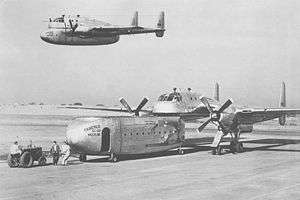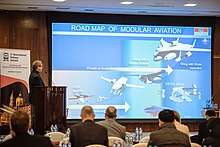Modular aircraft

A modular aircraft or pod plane is a type of aircraft design where the payload carrying part can be detached from the rest of the aircraft. In this way, the aircraft can have a much-reduced loading and unloading time or change between different configurations of cargo or passenger capability.[1] Pod planes have two main components: the flying component: airframe, cockpit and engines; and the capsules: detachable pods (cabin or cargo hold). The flying component and the individual capsules can be detached from each other and combined in different ways.
History
In November 1950, the Fairchild XC-120 Packplane first flew. This was an experimental military transport for the U.S. Air Force. Described as a futuristic "pod plane", it was a development of the C-119 Flying Boxcar. Although tested, the project was canceled without any further production.[2]
In 2005, the Air Force Research Laboratory proposed a similar concept for military and civilian use in the configurable air transport: a blended wing body aircraft with multiple detachable, ground-mobile pods.[3]
The Clip-Air has been proposed since 2009 by the École Polytechnique Fédérale de Lausanne [4]. Later, in 2017, Akka Technologies proposed a modular aircraft concept.[5]
Carpinteria, California-startup Dorsal Aircraft wants to make light standard ISO containers part of its unmanned freighter structure where the wing, engines and tail are attached to a dorsal spine fuselage. Interconnecting 5–50 ft (1.5–15.2 m) long aluminum containers carry the flight loads, aiming to lower overseas airfreight costs by 60%, and plan to convert C-130H with the help of Wagner Aeronautical of San Diego, experienced in passenger-to-cargo conversions.[6]
Some designs
Clip-Air

Clip-Air's design contains two main components: a flying wing (cockpit, motors, and fuel) and flexible modules (up to three ones) can carry passengers, freight, or fuel. This Clip-Air has maximum weight of 30 tons, a length of 30 meters and wing-span of 60 meters. A total of 450 passengers can be carried in the three modules. [7]
See also
- Flying tank, conceptualised in the early 1930s
- Fieseler Fi 333 (World War II), design studies only
- Savoia-Marchetti SM.105, post-World War II Italian project with detachable fuselage
- Fairchild XC-120 Packplane (1950), one prototype flown
- Sikorsky CH-54 Tarhe (1962), heavy-lift helicopter crane, also used with exchangeable cargo pods
- Kamov Ka-26 (1965), a piston light helicopter with a modular pod, succeeded by the single turbine Ka-126 (1988) and the twin-turbine Ka-226 (1997)
References
- ↑ Aviation Week, Volume 52. McGraw-Hill Publishing Company, 1950. pp. 13
- ↑ Popular Science Vol. 270, No. 1 (Jan 2007). Published by Bonnier Corporation. ISSN 0161-7370. pp. 104
- ↑ "Configurable Air Transport" (PDF). 43rd AIAA Aerospace Sciences Meeting and Exhibit. Air Force Research Laboratory. 10 January 2005.
- ↑ "Modular Aircraft Clip-Air". École Polytechnique Fédérale de Lausanne.
- ↑ "LINK&FLY" (Press release). Akka Technologies. 28 Sep 2017.
- ↑ Graham Warwick (Mar 19, 2018). "The Week In Technology, March 19-23, 2018". Aviation Week & Space Technology.
- ↑ "Technical aspects – Clip". Retrieved August 18, 2018.